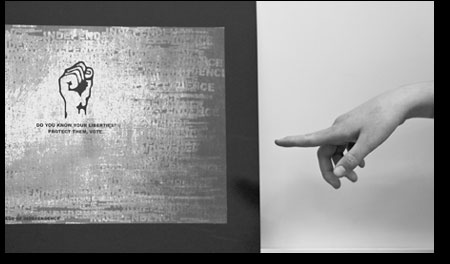|
| ||
| Political art on Main
by Jules Masterjohn “Personally, I always held my flower in a clenched fist.” – Abbie Hoffman The fist is a symbol of protest, a visual representation associated with resistance. It first appeared as early as 1917 in political graphics supporting the Mexican Revolution. Seeing it today, nearly 40 years after its proliferation in American political and social art, the symbol can trigger feelings of solidarity as well as uncertainty. The clenched fist raised in protest became especially provocative as a sign of militancy and this simple image of a closed hand can bring back memories of the turbulent late 1960s. Abbie Hoffman reminds us in his statement that peace – the flower – and struggle – the clenched fist – go hand in hand. Visual images are persuasive communicators. The powers-that-be figured this out during the Vietnam War when photojournalists captured the most heinous images of war with their cameras. Back then, political artists used these photographs to create protest posters that punctuated war’s inhumanity. These posters were widely distributed: pasted onto fences, walls, light posts, phone booths, billboards and buildings in major cities across the country. One particularly powerful protest poster uses a photographic image of a pile of children’s bodies lying in a dirt road. Made in 1970, the artists appropriated the photograph, which was published in Life magazine and taken by an Army combat photographer. Superimposed over the color photograph are two lines of text that frame the dead bodies. On the top is printed a question posed by reporter Mike Wallace and on the bottom is the answer from a Vietnam veteran regarding U.S. army actions during the My Lai massacre. It reads: “Q. And babies? A. And babies.” It is easy to understand why we no longer see photographs in the media that display the consequences of U.S. wars. These images are not good advertising. They show disturbing realities that cannot easily be driven from one’s mind and heart. For this very reason, we are no longer allowed to see caskets or body bags bearing American war dead. Understanding the provocative nature of visual images, in 1991 during Operation Desert Storm, the Department of Defense banned these types of photographs from the media – and our eyes. The Vietnam War era birthed a rich tradition of protest art that continued through the covert wars in Central America in the 1980s, the Iraq Wars of the ’90s and into today. Initiated by Durango Arts Center Director McCarson Jones, “Political Sidebar” is a one-evening event for artists to show and sell their politically themed artwork. Jones poses these questions in the event’s prospectus. “Tell me, how do you really feel about our current election, the current political situation worldwide? How exactly do you express that through your art? Do you take serious risks; do you dare identify yourself for fear of public persecution through art sales? Hell no!” She concludes, “It’s political, it’s risky, it’s real. It’s November 1st.” A group of Fort Lewis College art students have heard Jones’ call. Art professor Paul Booth gave his graphic design class an assignment to create a poster. Each student chose a political or social issue and, without using any photographs, created a visual statement with text and images to communicate her or his point of view. Jessica Hatley references protest posters by the use of a clenched fist. The word “liberty,” printed in subtle repeating patterns, makes up the background texture. Her text states, “Do you know your liberties? Protect them. Vote.” Other students presented posters on topics ranging from Stop Loss – the little known involuntary extension of service for military personnel – ethanol production, the Wolf Creek development, immigration, and the separation of church and state to the legalization of marijuana. Booth, too, will be contributing a poster, that plays off the American flag. Durango jeweler Tracey Belt will offer up an image of hope in the form of a hand-made belt buckle. She has attached a photocopy of her ballot to a metal plate and encapsulated it in resin. By removing the major opponent’s name from her ballot and leaving Obama’s bubble marked, she is symbolically stating, “he is the only choice for president.” She writes, “My piece is simple. With ‘Mementos,’ I want to remember this time, this point in our history as a nation, and to remember this feeling of hope for a new way of being an American citizen. I want to document filling in that bubble on the ballot.” Belt’s buckle will no doubt be sought after on Friday night as other “hopefuls” in attendance exchange Palinisms in a competition, vying for Belt’s unique memento of this historic election. Just kidding!! “Political Sidebar” will take place Sat., Nov. 1, from 6:30-9:30 p.m. at 1006 Main Ave., in Durango. $5 at the door. Food provided by Cyprus Café and music by DJ Niko. Proceeds benefit the Durango Arts Center programs. • To receive a prospectus for “Political Sidebar,” contact McCarson Jones at mccarsonjones@hotmail.com. Artworks are due on Oct. 31 along with a $40 entry fee.
|
In this week's issue...
- January 25, 2024
- Bagging it
State plastic bag ban is in full effect, but enforcement varies
- January 26, 2024
- Paper chase
The Sneer is back – and no we’re not talking about Billy Idol’s comeback tour.
- January 11, 2024
- High and dry
New state climate report projects continued warming, declining streamflows


